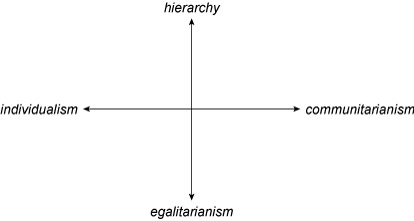2.1 Culture and risk
Public awareness and understanding of geoengineering is low. Surveys in the UK, USA and Canada indicate around a quarter have some familiarity with the word, and a few per cent can correctly define it (Scheer and Renn, 2014), though nearly half of respondents could define or guess the meaning of ‘climate engineering’ (Mercer et al., 2011). Once explained, majorities tend to favour CDR over SRM, and approaches perceived to be ‘natural’ (e.g. enhancing the existing carbon cycle) over those perceived to be ‘man-made’.
These results begin to hint at the importance of values in risk perception. There is evidence that humans perceive risks in ways that reflect and reinforce their cultural ways of life, such as how society should be run. This has been suggested as the reason for strong polarisation of views on climate science along political lines (Kahan et al., 2011).
One area of research that focuses on this idea is ‘cultural cognition theory’ (Kahan et al., 2011). This places people on two axes: one axis of individualism versus communitarianism, the other of hierarchy versus egalitarianism (Figure 4).

How strongly do you agree or disagree with each of these statements? Once you have completed all the statements, click ‘Show’ to see where you sit.
-
Do you think those who are more sceptical of the risks of climate change would tend to be further along the:
- a.‘individualism’ or ‘communitarianism’ directions of the horizontal axis?
- b.‘hierarchy’ or ‘egalitarianism’ directions of the vertical axis?
-
Studies by Kahan et al. (2011, 2015) have found that those who are closer to the ‘individualism’ and ‘hierarchy’ ends of these axes tend to be more sceptical of environmental risks such as climate change.
There may also be an interesting interplay between cultural values, geoengineering and perception of climate risk. Those who are ‘hierarchical’ tend to favour geoengineering, and those who are ‘egalitarian’ tend to be cautious or dismissive (Scheer and Renn, 2014). So it could be that cultural values affect the perception of geoengineering.
